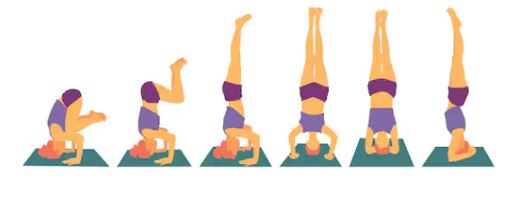Shirshasana : Yoga is a kind of exercise in which a practitioner locomotes the human body into several distinct and diverse positions in order to attain physical fitness and flexibility. While performing yogic exercises the sadhak has to invariably pay attention to the breath. An insight into Shirshasana The asana basically involves inverting the body, with hands,
Yoga is a kind of exercise in which a practitioner locomotes the human body into several distinct and diverse positions in order to attain physical fitness and flexibility. While performing yogic exercises the sadhak has to invariably pay attention to the breath.

An insight into Shirshasana
The asana basically involves inverting the body, with hands, neck and shoulders bearing the entire weight of the body. The first step is the Vajrasana. Through a series of fluid steps to be executed in slow, measured pace, the practitioner moves from Vajrasana to the final pose where the legs are held straight up, toes pointing upwards and the arms cradling the head, with the elbows bent at right angles for further support.
As a practitioner holds the pose, it works against the pressure of gravity, assisting in draining impure blood from the lower limbs and also enhancing blood flow to the head and neck regions.
Moving out the asana has also to be done at the same measured pace in order to prevent injuries. This involves literally tracing all the steps backwards until one moves into Shishuasana.
Regular practitioners can remain in the position for as long as 30 minutes without any encumbrance, while beginners are advised to start with as little as 3 minutes.
Novitiates are advised to practice Shirshasana at the end of their yogic asana programme while advanced practitioners can perform it either at the beginning or the end of a yogic session. Shirshasana should invariably follow a session of Shavasana to relax the body.
It may be mentioned that the asana is very robust to awaken the Sahasrara chakra, which is responsible for the lofty position this sovereign among asanas enjoys.
Shirshasana enhances the blood supply to the brain and pituitary gland, and in the process revitalises the entire body and mind. Regular practice disgorges perturbation and other psychological intrusions which often become the bedrock of numerous disabilities.
The asana is therefore, recommended for the prevention of asthma, hay fever, diabetes and menopausal imbalance. It also assists to rectify several forms of nervous and glandular disorders, especially those related to the reproductive system.
A note of caution
Shirshasana is contra-indicated for those individuals suffering with high blood pressure, heart disease, thrombosis, arteriosclerosis, chronic catarrh (excessive build-up of mucus in the nose or throat), chronic constipation, kidney problems, impure blood, severe near-sightedness, weak eye blood vessels, conjunctivitis, and chronic glaucoma, inflammation of the ears, any form of haemorrhage in the head. It should neither be practiced during pregnancy nor during menstruation.
While it is recommended as a preventative measure for headache or migraine, it should not be practiced while suffering from the ailment.
It goes without saying that the tutee should learn the craft under the careful guidance and supervision of a trained yoga instructor and practice for some time under the grace of a Guru.
Click Here to Read more




